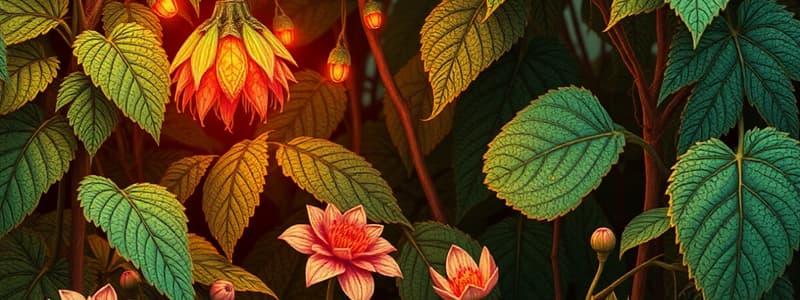Podcast
Questions and Answers
What is hydrotropism?
What is hydrotropism?
- A growth response of an organism towards moisture (correct)
- A growth response of an organism towards light
- A movement away from heat
- A response to sound waves
Which statement accurately describes negative thermotropism?
Which statement accurately describes negative thermotropism?
- Growth away from a source of heat or cold (correct)
- Growth towards a source of cold
- Movement in response to gravity
- Growth towards a source of heat
What distinguishes nastic movements from tropisms in plants?
What distinguishes nastic movements from tropisms in plants?
- Nastic movements are directional
- Tropisms are faster than nastic movements
- Tropisms occur in response to non-directional stimuli
- Nastic movements are non-directional responses (correct)
What type of movement does positive hydrotropism involve?
What type of movement does positive hydrotropism involve?
Which term describes observable biological oscillations with a 24-hour periodicity?
Which term describes observable biological oscillations with a 24-hour periodicity?
What is the definition of a tropism in plants?
What is the definition of a tropism in plants?
What type of tropism occurs when a plant grows towards light?
What type of tropism occurs when a plant grows towards light?
Which term describes the growth of plant roots in response to gravity?
Which term describes the growth of plant roots in response to gravity?
What does negative gravitropism refer to?
What does negative gravitropism refer to?
What is hydrotropism in plants primarily concerned with?
What is hydrotropism in plants primarily concerned with?
Which mechanism allows plants to respond to touch stimuli?
Which mechanism allows plants to respond to touch stimuli?
What is a key survival advantage of phototropism?
What is a key survival advantage of phototropism?
Which type of plant growth occurs as a reaction to high water availability?
Which type of plant growth occurs as a reaction to high water availability?
Flashcards
Positive Hydrotropism
Positive Hydrotropism
The growth of a plant towards moisture.
Negative Hydrotropism
Negative Hydrotropism
The growth of a plant away from moisture.
Thermotropism
Thermotropism
The movement of a plant in response to a change in temperature.
Circadian Rhythm
Circadian Rhythm
Signup and view all the flashcards
Nastic Movement
Nastic Movement
Signup and view all the flashcards
Tropism
Tropism
Signup and view all the flashcards
Phototropism
Phototropism
Signup and view all the flashcards
Positive Phototropism
Positive Phototropism
Signup and view all the flashcards
Negative Phototropism
Negative Phototropism
Signup and view all the flashcards
Positive Thigmotropism
Positive Thigmotropism
Signup and view all the flashcards
Negative Thigmotropism
Negative Thigmotropism
Signup and view all the flashcards
Gravitropism
Gravitropism
Signup and view all the flashcards
Study Notes
Plant Tropisms
- Organisms adapt to changing environments.
- Plants respond to stimuli, but more slowly than animals.
- Plants are sessile, meaning they can't move, and must adapt differently than animals.
- Plant tropisms are mechanisms by which plants adapt to their environment.
Definition of Tropism
- A tropism is a growth response of a plant toward or away from a stimulus.
- A response to a stimulus (an environmental factor) results in growth toward or away from that stimulus
Common Stimuli
- Common stimuli influencing plant growth include light, gravity, water, and touch.
- These stimuli trigger growth responses in plants
Types of Tropisms
Positive Tropism
- Positive tropism describes growth towards a stimulus.
Negative Tropism
- Negative tropism describes growth away from a stimulus.
Phototropism
-
Phototropism is the growth response to light.
-
"Photo" refers to light, and "tropism" refers to turning.
-
Plants tend to grow towards a light source (positive phototropism).
-
Phototropism is a plant's reaction to light, and it causes the plant to bend towards the light.
-
Auxin, a plant hormone, plays a key role in phototropism. Auxin accumulates on the shaded side of the plant, triggering cell elongation on that side and causing the plant to bend towards the light.
Importance of Phototropism
-
Plants need light for photosynthesis, the process where they produce energy.
-
Phototropism ensures that plants maximize their exposure to sunlight for efficient photosynthesis.
-
The bending of plants towards light is a critical survival mechanism. Plants need sunlight for photosynthesis; therefore, they favor greater exposure to the light
Thigmotropism
- Thigmotropism is the directional movement of a plant in response to touch.
- Positive thigmotropism: growth towards a touch stimulus (e.g., vines climbing a wall).
- Negative thigmotropism: growth away from a touch stimulus.
Geotropism (Gravitropism)
- Geotropism, or gravitropism, is the growth response to gravity.
- Positive geotropism: roots grow downward towards gravity.
- Negative geotropism: shoots grow upward against gravity.
Hydrotropism
- Hydrotropism is the directional growth response to water.
- Positive hydrotropism: roots grow towards water sources.
- Negative hydrotropism: avoidance of excess water.
Thermotropism
- Thermotropism is the movement of a part of or the whole plant in response to changes in temperature.
- Positive Thermotropism: growth toward heat or cold
- Negative Thermotropism: growth away from heat or cold
Circadian Rhythm
- Observable oscillations in a plant with 24-hour patterns.
Nastic Movements
- Plant movements in response to stimuli (e.g. touch, light and heat), but are different than tropisms.
- Non-directional, in contrast to tropisms, which are directional.
Photonastic Movement
- A nastic movement caused by light stimuli.
- Example: the opening of Mirabilis jalapa flowers at certain times.
Thigmonastic Movement
- A nastic movement caused by touch stimuli.
- Example: the Venus flytrap closing its leaves when a fly lands on the leaves.
Studying That Suits You
Use AI to generate personalized quizzes and flashcards to suit your learning preferences.



